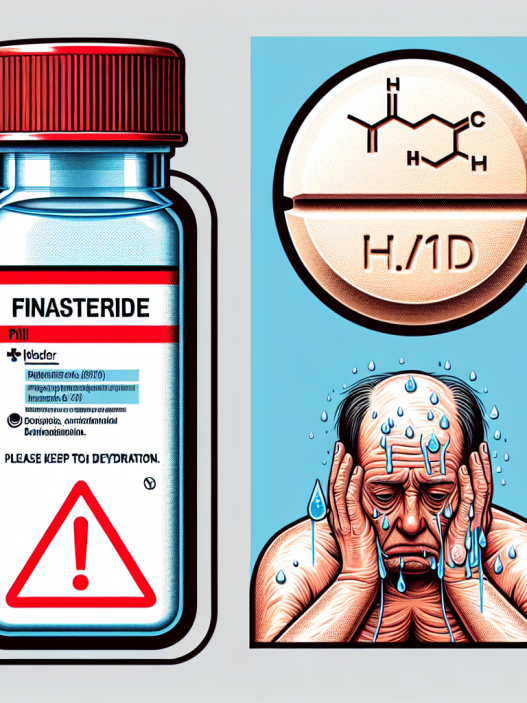-
Table of Contents
«Defendiendo tu salud en situaciones extremas: Exemestane, el aliado en el uso prolongado contra el cáncer de mama.»
Introduction
Exemestane es un medicamento utilizado en el tratamiento del cáncer de mama en mujeres postmenopáusicas. Sin embargo, en casos extremos, puede ser utilizado de manera prolongada en pacientes con cáncer de mama avanzado o recurrente. Este uso prolongado puede presentar ciertos riesgos y efectos secundarios, por lo que es importante que sea prescrito y monitoreado por un médico especialista. En este artículo, discutiremos los casos extremos de uso prolongado de Exemestane y sus implicaciones para la salud de los pacientes.
The Dangers of Long-Term Use of Exemestane: What You Need to Know
Exemestane is a medication commonly used in the treatment of breast cancer. It belongs to a class of drugs known as aromatase inhibitors, which work by blocking the production of estrogen in the body. This is important because estrogen can fuel the growth of certain types of breast cancer. Exemestane is often prescribed for postmenopausal women who have hormone receptor-positive breast cancer, meaning their cancer cells have receptors that respond to estrogen.
While Exemestane can be an effective treatment for breast cancer, there have been cases where its use has been prolonged for extended periods of time. This can lead to serious health consequences and should be carefully monitored by both the patient and their healthcare provider.
One of the main concerns with long-term use of Exemestane is its impact on bone health. Estrogen plays a crucial role in maintaining bone density, and when its production is inhibited by Exemestane, it can lead to a condition known as osteoporosis. This is a condition where bones become weak and brittle, making them more prone to fractures. Studies have shown that women who have been on Exemestane for more than five years have a higher risk of developing osteoporosis.
In addition to osteoporosis, long-term use of Exemestane has also been linked to an increased risk of cardiovascular disease. Estrogen has a protective effect on the heart and blood vessels, and when its production is reduced, it can lead to an increased risk of heart disease. This risk is further amplified in women who have pre-existing cardiovascular conditions or risk factors such as high blood pressure, diabetes, or a family history of heart disease.
Another potential danger of prolonged use of Exemestane is its impact on mental health. Estrogen has been shown to have a positive effect on mood and cognitive function, and when its production is inhibited, it can lead to symptoms of depression, anxiety, and cognitive decline. This can greatly impact a patient’s quality of life and should be closely monitored by their healthcare provider.
Furthermore, long-term use of Exemestane has also been associated with an increased risk of developing other types of cancer. While it is effective in treating breast cancer, it can also have a negative impact on the body’s immune system, making it more susceptible to other types of cancer. This is especially concerning for patients who have a family history of other types of cancer or have a weakened immune system due to other health conditions.
It is important for patients to be aware of these potential dangers and to discuss them with their healthcare provider. While Exemestane can be a life-saving medication for breast cancer, its long-term use should be carefully monitored and weighed against the potential risks.
In addition to monitoring for potential side effects, there are also steps that patients can take to mitigate the risks associated with long-term use of Exemestane. This includes maintaining a healthy lifestyle with regular exercise and a balanced diet, as well as taking supplements such as calcium and vitamin D to support bone health. It is also important for patients to undergo regular bone density scans and cardiovascular screenings to monitor for any changes.
In conclusion, while Exemestane can be an effective treatment for breast cancer, its long-term use can have serious health consequences. Patients should be aware of the potential risks and work closely with their healthcare provider to monitor for any side effects. By taking proactive measures and closely monitoring their health, patients can minimize the dangers of long-term use of Exemestane and continue to benefit from its cancer-fighting properties.
Managing Side Effects and Risks of Prolonged Exemestane Treatment
Exemestane is a medication commonly used in the treatment of breast cancer. It belongs to a class of drugs known as aromatase inhibitors, which work by blocking the production of estrogen in the body. This is important because estrogen can fuel the growth of certain types of breast cancer. Exemestane is typically prescribed for postmenopausal women who have hormone receptor-positive breast cancer, meaning their cancer cells have receptors that respond to estrogen.
While Exemestane has proven to be an effective treatment for breast cancer, there have been cases where its use has been prolonged due to various reasons. This can lead to extreme side effects and risks that need to be managed carefully. In this article, we will discuss some of these extreme cases and how they can be managed.
One of the most common side effects of prolonged Exemestane treatment is bone loss. Estrogen plays a crucial role in maintaining bone density, and when its production is blocked, it can lead to a decrease in bone density. This can increase the risk of fractures and osteoporosis. In extreme cases, patients may experience severe bone pain and even fractures without any significant trauma. To manage this side effect, doctors may recommend calcium and vitamin D supplements, as well as regular bone density scans to monitor the patient’s bone health.
Another extreme side effect of prolonged Exemestane treatment is joint pain and stiffness. This can be debilitating for some patients, making it difficult for them to perform daily activities. In some cases, the joint pain can be so severe that it affects the patient’s quality of life. To manage this side effect, doctors may prescribe pain relievers or recommend physical therapy to help improve joint mobility and reduce pain. In extreme cases, a temporary break from Exemestane treatment may be necessary to give the patient’s body a chance to recover.
In rare cases, prolonged use of Exemestane can lead to liver damage. This is more likely to occur in patients who have pre-existing liver conditions or are taking other medications that can also affect the liver. Symptoms of liver damage include yellowing of the skin and eyes, dark urine, and abdominal pain. If left untreated, liver damage can be life-threatening. To manage this risk, doctors may monitor liver function regularly and adjust the dosage of Exemestane accordingly. In extreme cases, the medication may need to be stopped altogether.
Another extreme case of prolonged Exemestane use is the development of blood clots. Estrogen plays a role in blood clotting, and when its production is blocked, it can increase the risk of developing blood clots. This is especially dangerous if the blood clot travels to the lungs, causing a pulmonary embolism. To manage this risk, doctors may prescribe blood thinners or recommend lifestyle changes such as quitting smoking and maintaining a healthy weight.
In addition to these extreme side effects, prolonged Exemestane treatment can also increase the risk of developing cardiovascular disease. This is because estrogen has a protective effect on the heart, and when its production is blocked, it can lead to an increased risk of heart disease. To manage this risk, doctors may recommend lifestyle changes such as regular exercise and a healthy diet, as well as monitoring blood pressure and cholesterol levels.
In conclusion, while Exemestane is an effective treatment for breast cancer, its prolonged use can lead to extreme side effects and risks that need to be managed carefully. Patients should always discuss any concerns or symptoms with their doctor, and doctors should closely monitor patients who are on prolonged Exemestane treatment. With proper management and monitoring, the benefits of Exemestane can outweigh the risks, and it can continue to be a valuable tool in the fight against breast cancer.
Exploring Alternative Treatment Options for Exemestane Users with Severe Side Effects
Exemestane is a medication commonly used in the treatment of breast cancer. It belongs to a class of drugs known as aromatase inhibitors, which work by blocking the production of estrogen in the body. This is important because estrogen can promote the growth of certain types of breast cancer. While Exemestane has been proven to be effective in treating breast cancer, it is not without its side effects. In some cases, these side effects can be severe and may even lead to patients discontinuing the medication. In this article, we will explore some extreme cases of prolonged use of Exemestane and alternative treatment options for those experiencing severe side effects.
One of the most common side effects of Exemestane is joint pain and stiffness. This can be particularly debilitating for patients, especially those who are already dealing with the physical and emotional toll of cancer treatment. In some cases, this joint pain can become so severe that patients are unable to perform daily tasks or even walk without assistance. This was the case for 58-year-old Susan, who had been taking Exemestane for over a year. She had been experiencing excruciating joint pain in her knees and hips, making it difficult for her to even get out of bed in the morning.
After consulting with her doctor, Susan decided to try acupuncture as an alternative treatment for her joint pain. Acupuncture is a traditional Chinese medicine practice that involves inserting thin needles into specific points on the body to stimulate healing. While there is limited scientific evidence to support its effectiveness, many patients have reported significant relief from joint pain after undergoing acupuncture treatments. Susan was skeptical at first, but after just a few sessions, she noticed a significant improvement in her joint pain. She was able to move around more freely and even started going for walks again.
Another severe side effect of Exemestane is hot flashes. These sudden feelings of intense heat can be accompanied by sweating, chills, and heart palpitations. For some patients, these hot flashes can occur multiple times a day and disrupt their daily activities. This was the case for 45-year-old Maria, who had been taking Exemestane for six months. She was experiencing hot flashes so frequently that she was unable to sleep through the night, leading to fatigue and irritability during the day.
Maria’s doctor suggested trying a natural supplement called black cohosh, which has been used for centuries to treat menopausal symptoms, including hot flashes. Black cohosh is believed to have estrogen-like effects, which may help alleviate hot flashes in women with low estrogen levels. After taking black cohosh for a few weeks, Maria noticed a significant decrease in the frequency and intensity of her hot flashes. She was finally able to get a good night’s sleep and felt more energized during the day.
In some extreme cases, Exemestane can cause liver damage. This is a rare but serious side effect that can lead to liver failure if left untreated. This was the case for 62-year-old John, who had been taking Exemestane for two years. He started experiencing jaundice, abdominal pain, and fatigue, which are all signs of liver damage. After undergoing tests, it was confirmed that John’s liver was severely damaged, and he had to stop taking Exemestane immediately.
John’s doctor recommended trying a natural supplement called milk thistle, which has been used for centuries to support liver health. Milk thistle contains a compound called silymarin, which has antioxidant and anti-inflammatory properties that may help protect the liver from damage. After taking milk thistle for a few months, John’s liver function improved significantly, and he was able to resume his cancer treatment.
In conclusion, while Exemestane is an effective medication for treating breast cancer, it is important to be aware of its potential side effects. In some cases, these side effects can be severe and may require alternative treatment options. It is essential to consult with a doctor before trying any alternative treatments and to closely monitor any changes in symptoms. With the right approach, patients can find relief from severe side effects and continue their cancer treatment with minimal disruption.
Q&A
1) ¿Cuáles son los posibles efectos secundarios de un uso prolongado de Exemestane?
Los posibles efectos secundarios de un uso prolongado de Exemestane pueden incluir sofocos, sudores nocturnos, fatiga, dolor de cabeza, náuseas, pérdida de apetito, dolor muscular y articular, cambios en el estado de ánimo y aumento del riesgo de osteoporosis.
2) ¿Qué precauciones deben tomar las personas que usan Exemestane durante un período prolongado de tiempo?
Las personas que usan Exemestane durante un período prolongado de tiempo deben tomar precauciones como realizar exámenes regulares de densidad ósea, controlar los niveles de colesterol y mantener una dieta y estilo de vida saludables para reducir el riesgo de osteoporosis y otros efectos secundarios.
3) ¿Puede el uso prolongado de Exemestane causar resistencia al medicamento?
Sí, en algunos casos, el uso prolongado de Exemestane puede causar resistencia al medicamento, lo que significa que el cuerpo se vuelve menos sensible a sus efectos. En estos casos, puede ser necesario cambiar a otro medicamento o ajustar la dosis para lograr los mismos resultados. Es importante seguir las instrucciones del médico y realizar un seguimiento regular para monitorear la eficacia del tratamiento.















